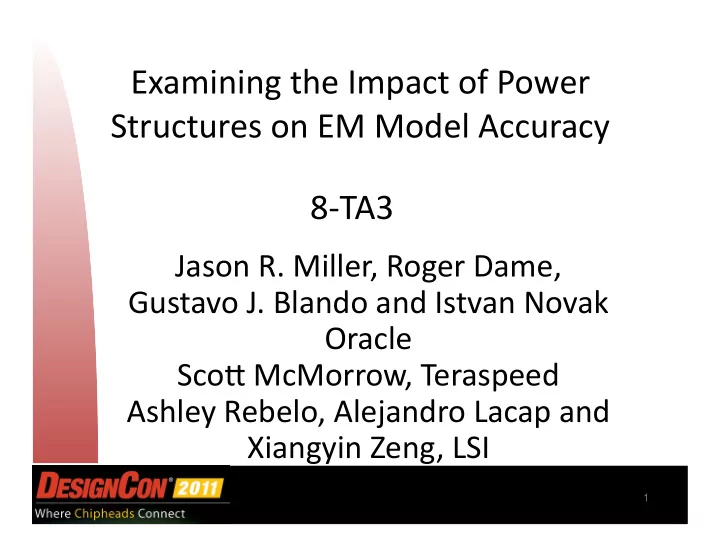

Examining ¡the ¡Impact ¡of ¡Power ¡ Structures ¡on ¡EM ¡Model ¡Accuracy ¡ 8-‑TA3 ¡ Jason ¡R. ¡Miller, ¡Roger ¡Dame, ¡ ¡ Gustavo ¡J. ¡Blando ¡and ¡Istvan ¡Novak ¡ Oracle ¡ ScoK ¡McMorrow, ¡Teraspeed ¡ Ashley ¡Rebelo, ¡Alejandro ¡Lacap ¡and ¡ Xiangyin ¡Zeng, ¡LSI ¡ 1
Introduction • 3D FWS are considered to be some of the most accurate field solvers • With typical compute resources, it isn’t practical to analyze whole packages • Consequently, 3D EM models are often developed with certain assumptions to reduce solve time
Introduction • Implicit or explicit assumptions can impact model accuracy • For example, high-frequency return current resides underneath or in vicinity of trace. But what happens at via transitions? • Investigate the accuracy and limitations of these assumptions Questions: • What is missed by sectioning or truncating the package? • What interaction happens on the scale of typical packages? • What field solvers can we use to simulate whole packages? • Ultimately, how can we develop more accurate models?
Agenda • Brief theory of cavity resonances • Signal and cavity interactions Excitation of cavities Modifying cavity resonances Containment vias • Boundary conditions • Another Take on Via Impedance & Field non-locality • Simulating signal-plane cavity interactions Two package examples Buildup vias versus core vias • Correlation to measurements • Summary
Brief Theory of Cavity Resonances 590 MHz 1 MHz 295 MHz 139 MHz
Signal Excitation of Plane Cavities • Transmission line mode to parallel plane waveguide mode Signal path discontinuity, e.g. due to a split Via transitions • Focus here is on excitation of cavities from signal vias transitioning through cavities.
Signal and Cavity Interactions
Modifying Cavity Resonances
Modifying Cavity Resonances
Containment Vias
Solver Boundary Conditions
Solver Boundary Conditions z y x x-y-z absorbing boundary x-z open boundary
Solver Boundary Conditions y z x x-y-z open boundary absorbing boundary 3 mm vs. 8 mm 3 mm vs. 8 mm
Containment Vias Absorbing Boundary Magnetic Boundary
Another Take on Via Impedance
Non-locality of Fields
Non-locality of Fields
Coupled Differential Via Correlation measured simulated
Simulating Signal-Plane Cavity Interactions Ansoft HFSS (truncated) Ansoft SIwave (full package) Ansoft SIwave (truncated)
Simulating Signal-Plane Cavity Interactions Ansoft SIwave (full package) Ansoft HFSS (truncated)
Differential vs. Single Ended Signals • In general differential signals show less IL and crosstalk peaking due to cavity modal resonances • BUT mode conversion and NEXT will not make this go away • NEXT is not subjected to channel losses If Rx is subjected to say 20 dB channel loss than every channel will have 1-10% crosstalk • Also note that this crosstalk is NOT localized, i.e. simply separating Rx and Tx doesn’t necessarily address this
Simulating Signal-Plane Cavity Interactions measured Simulated (full package) Extend plane Simulated as-is
Thin Buildup Layer Test Design Do those thin layers help? Without With Adjacent Adjacent Grounds Grounds
Thin Buildup Layer Via Excitation Simulation Comparison 21 GHz 25 GHz 27 GHz Signal vias only Ground vias adjacent to signal Closest ground via 1 mm away vias Green – SIwave Blue - HFSS
Thin Buildup Layer Via Excitation Simulation Comparison 21 GHz 25 GHz 27 GHz 21GHZ 27GHZ 25GHZ Signal vias only Ground vias adjacent to signal Closest ground via 1 mm away vias Green – SIwave Blue - HFSS
Conservation of Misery • Without additional dissipation, ground vias only serve to move resonance problems out of band. • The higher the frequency, the harder it is to “Whack” the mole.
Summary • Package model extraction using truncated or segmented models has assumptions and limitations • Vertical transitions in packages and PCBs can excite cavities • Cavity resonances can have a significant impact on the signal loss, crosstalk and return loss • Cavity resonances can generate crosstalk that is highly non- localized (as we saw from the e-fields distribution plots) • Boundary conditions also determine whether these resonances are captured • “Containing” the energy in a vertical transition may be an option but may introduce its own resonances and may not be practical
Summary • Capturing the signal to plane pair cavity coupling can require that electrically large structures are simulated. • Hybrid solvers are a good choice for analyzing this type of problem if they are characterized against benchmark structures and their limitations understood
Recommend
More recommend